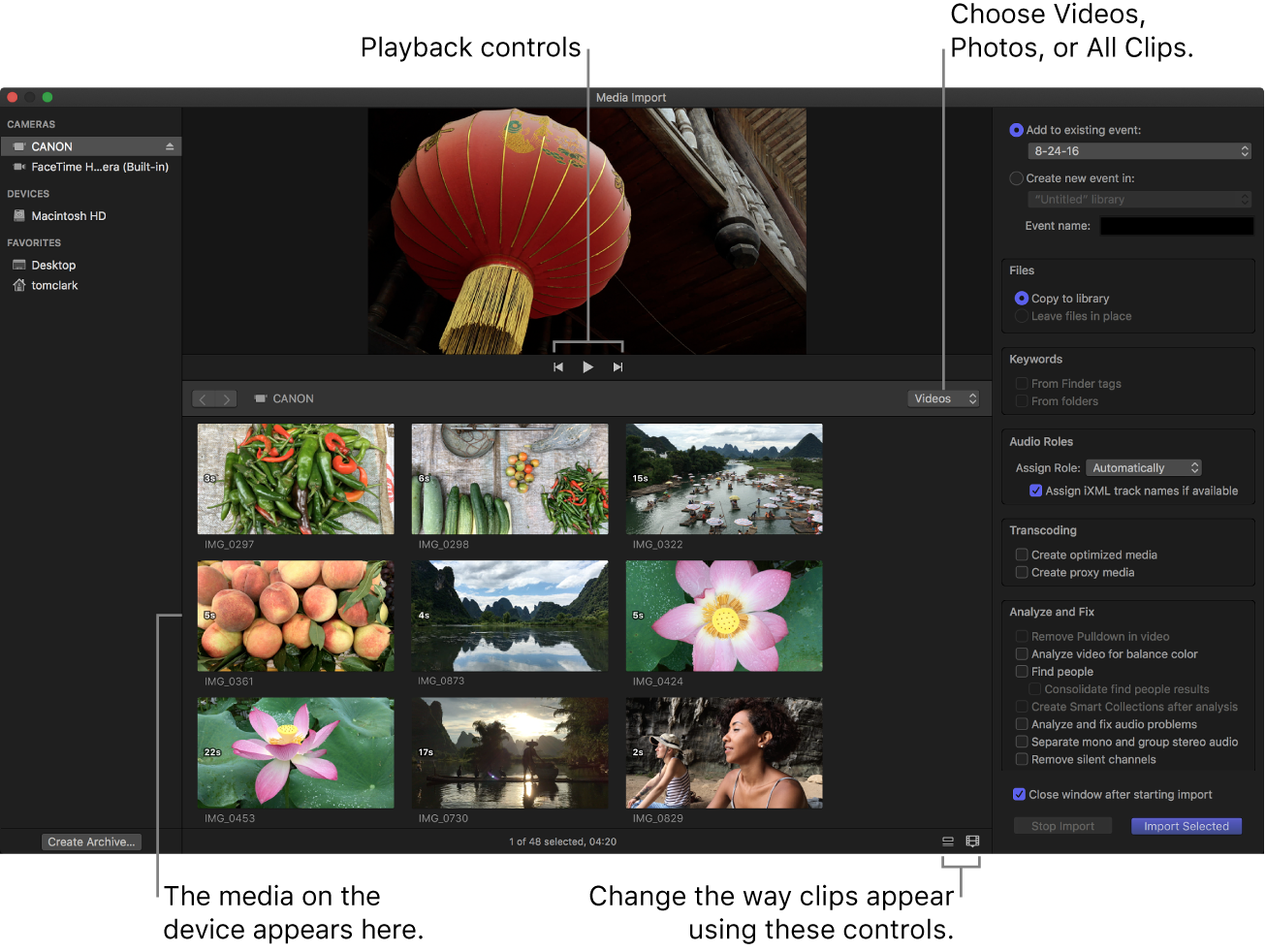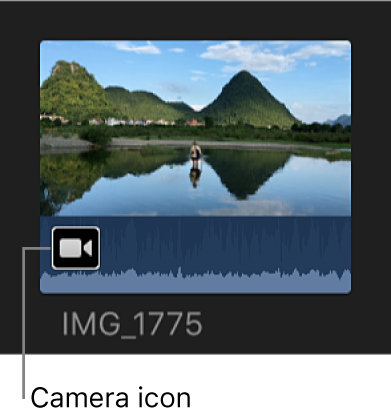
Import into Final Cut Pro for Mac from file-based cameras
File-based camcorders and cameras can record video, audio, and still images. These kinds of devices, which record to flash-based storage media, hard drives, and so on, usually connect to your Mac through a Thunderbolt or USB cable. Some devices have removable memory cards that you can insert into your computer instead.
If your file-based device provides a clip-spanning feature (which allows a single clip to be recorded across multiple memory cards), you can import all of the media as one spanned clip.
To check whether your camera is compatible with Final Cut Pro, see the Apple Support article Cameras supported by Final Cut Pro.
Import from a file-based camcorder, camera, or device
Do one of the following:
Connect your camcorder, camera, or device to your Mac using the cable that came with the device, and turn on the device.
If you’re using a camcorder, set it to PC Connect mode. (The name of this transfer mode may be different on your device.) Your camcorder may automatically go into “connect” mode if you turn it on in playback mode while it’s connected to your Mac. See the documentation that came with your camcorder.
Note: Connecting a DVD camcorder to your Mac can cause the DVD Player app to open. If that happens, simply close DVD Player.
Remove the memory card from your camcorder or device and insert it into the card slot on your Mac (if it has one) or into an external card reader.
See Memory cards and cables used with Final Cut Pro for Mac.
Note: Some cameras require that you download and install an additional software plug-in. See the documentation that came with your camera.
In Final Cut Pro, do one of the following:
Choose File > Import > Media (or press Command-I).
Click the Import Media button on the left side of the toolbar.

If necessary, select your camcorder, camera, or device from the Cameras section on the left.
The Media Import window displays the media on your device. You can play back your media using the playback controls or skim it by moving the pointer forward or backward over a filmstrip.

Note: By default, the Media Import window is set to show only video clips. If you want to display just photos, or video clips and photos, use the pop-up menu in the middle-right area of the window.
Do any of the following:
Change which device to import from: Click the device in the Cameras section.
Change the way the clips appear: Click the Clip Appearance button in the bottom-right corner of the Media Import window.
Switch between filmstrip view and list view: Click the List View and Filmstrip View buttons at the bottom of the Media Import window (connected file-based cameras and camera archives only).
Note: When you select a clip in list view, a filmstrip for the selected clip appears at the top of the browser. You can skim to any frame in the filmstrip and set start and end points.
Sort clips in list view by data such as duration, creation date, rating, keyword, and file type: Click the column headings at the top of list view. Control-click column headings to add additional columns. For more information about list view, see Import into Final Cut Pro for Mac from your Mac or storage device.
Add folders of frequently used media to the Favorites section: Drag them from list view.
To remove a folder from the Favorites section, Control-click the folder and choose Remove from Sidebar.
Automatically close the Media Import window when the import begins: Select the “Close window after starting import” checkbox.
Add a folder to list view by dragging: Drag the folder from the Finder to list view and browse its contents in list view.
Use the settings on the right side of the Media Import window to choose how you want to organize the imported media in your library:
Add the imported clips to an existing event: Select “Add to existing event,” then choose the event from the pop-up menu.
Create a new event: Select “Create new event in,” use the pop-up menu to choose the library in which you want to create the event, then type a name (for example, “Chris and Kim Wedding”) in the text field.
To learn more about events, see Intro to libraries in Final Cut Pro for Mac. If you want to import media into a new library, you must create the new library before importing your media.
Note: You can set storage locations for each of your libraries. See Set storage locations in Final Cut Pro for Mac.
If you want to override automatic role assignment, create optimized or proxy media, analyze the video, or analyze the audio, select the relevant settings in the Audio Roles, Transcoding, and Analyze sections.
If you don’t set Final Cut Pro to analyze your media during the import process, you can analyze it later in the browser.
Note: Some import options are available only when you import files from a storage device. See Organize files during import into Final Cut Pro for Mac and Import into Final Cut Pro for Mac from your Mac or storage device.
Do one of the following:
Import all clips: Click Import All.
Import only some of the clips: Select each clip you want to import by Command-clicking it, then click Import Selected (the Import button changes its name).
Tip: To select several clips located together, drag a selection rectangle around the clips.
Import portions of clips: Drag inside the filmstrip to select the range that you want, then click Import Selected. You can also select multiple ranges in each clip. See Select ranges in Final Cut Pro for Mac.
Tip: You can also select a clip, press the Space bar to play the clip, and then press either I (to set a start point) or O (to set an end point).
By default, the Media Import window closes when you click Import. You can begin working with your clips in the browser. The media is imported in the background.
If you selected any options in the previous step, the files are transcoded and optimized after the import is complete. You can view the progress of the import and other background tasks in the Background Tasks window.
When background tasks are completed, disconnect the camcorder, camera, or device.
You can create an archive from your file-based or tape-based camera or device. See Create camera archives in Final Cut Pro for Mac.
Reimport a clip
Two situations warrant reimporting a clip:
If the clip was not completely imported: If you cancel or quit Final Cut Pro before an import is finished, a camera icon appears on the bottom-left corner of the clip, indicating that the media on the camera is being used for playback (instead of the QuickTime file that was created during import).

To play a clip with a camera icon, Final Cut Pro locates the media either on a connected camera or in a connected, available camera archive. (See Import into Final Cut Pro for Mac from an archive or disk image.) If the media can’t be found in one of those locations, the clip becomes offline and displays the Missing Camera alert icon.
If the clip’s source media file is not available: If a clip’s source media file is moved or deleted, or the volume it’s located on is disconnected from your Mac, a Missing File alert icon appears on the clip. To restore the clip, you can reimport it.
See Alert icons in Final Cut Pro for Mac.
When you reimport a clip, Final Cut Pro automatically connects to the camera or camera archive. You don’t need to manually mount a camera archive before reimporting.
Do one of the following:
Connect the camera that contains the clip to your Mac, and turn on the camera.
The clip is now online but still displays the camera icon in the lower-left corner.
Insert the memory card that contains the clip into your Mac or a connected card reader.
See Memory cards and cables used with Final Cut Pro for Mac.
Make sure the camera archive that contains the clip is located in one of the Final Cut Pro camera archives.
In Final Cut Pro, do one of the following:
Choose File > Import > Reimport from Camera/Archive.
Download this guide: PDF